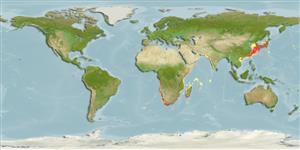Common names from other countries
Environment: milieu / climate zone / depth range / distribution range
Écologie
marin benthopélagique; profondeur 20 - 400 m (Ref. 6637). Temperate
Indo-West Pacific: Mozambique and South Africa (Ref. 6637), Japan and the East China Sea. Southeast Atlantic: Cape, South Africa (Ref. 6637).
Taille / Poids / Âge
Maturity: Lm ? range ? - ? cm
Max length : 150 cm TL mâle / non sexé; (Ref. 559); poids max. publié: 16.1 kg (Ref. 40637)
Description synthétique
Clés d'identification | Morphologie | Morphométrie
Épines dorsales (Total) : 9 - 10; Rayons mous dorsaux (Total) : 13 - 14; Épines anales: 3; Rayons mous anaux: 12 - 13. Adults black in color; juveniles dusky silver.
Adults found in deep rocky areas; young found in shallow water. The diet consists of fishes, crustaceans and squids. Spawns from October to March.
Life cycle and mating behavior
Maturities | Reproduction | Spawnings | Egg(s) | Fecundities | Larves
Heemstra, P.C., 1986. Scombropidae. p. 563. In M.M. Smith and P.C. Heemstra (eds.) Smiths' sea fishes. Springer-Verlag, Berlin. (Ref. 6637)
Statut dans la liste rouge de l'IUCN (Ref. 130435)
CITES (Ref. 128078)
Not Evaluated
Menace pour l'homme
Harmless
Utilisations par l'homme
Outils
Articles particuliers
Télécharger en XML
Sources Internet
Estimates based on models
Preferred temperature (Ref.
115969): 10.4 - 22.6, mean 18.2 (based on 218 cells).
Phylogenetic diversity index (Ref.
82804): PD
50 = 0.7500 [Uniqueness, from 0.5 = low to 2.0 = high].
Bayesian length-weight: a=0.01072 (0.00415 - 0.02764), b=3.02 (2.80 - 3.24), in cm Total Length, based on LWR estimates for this (Sub)family-body shape (Ref.
93245).
Niveau trophique (Ref.
69278): 4.2 ±0.63 se; based on food items.
Résilience (Ref.
120179): Faible, temps minimum de doublement de population : 4,5 à 14 années (K=0.12).
Fishing Vulnerability (Ref.
59153): High to very high vulnerability (68 of 100).
